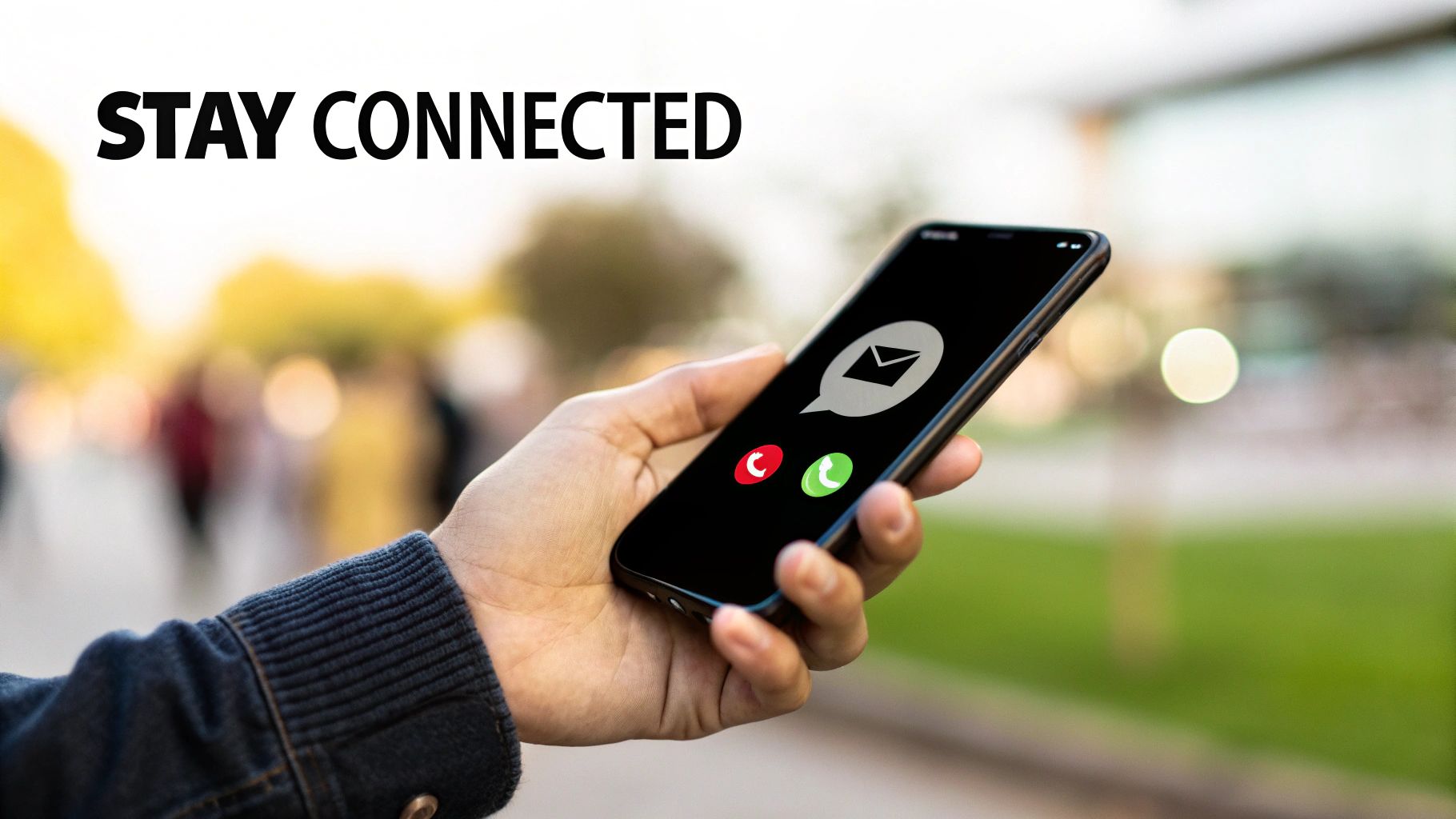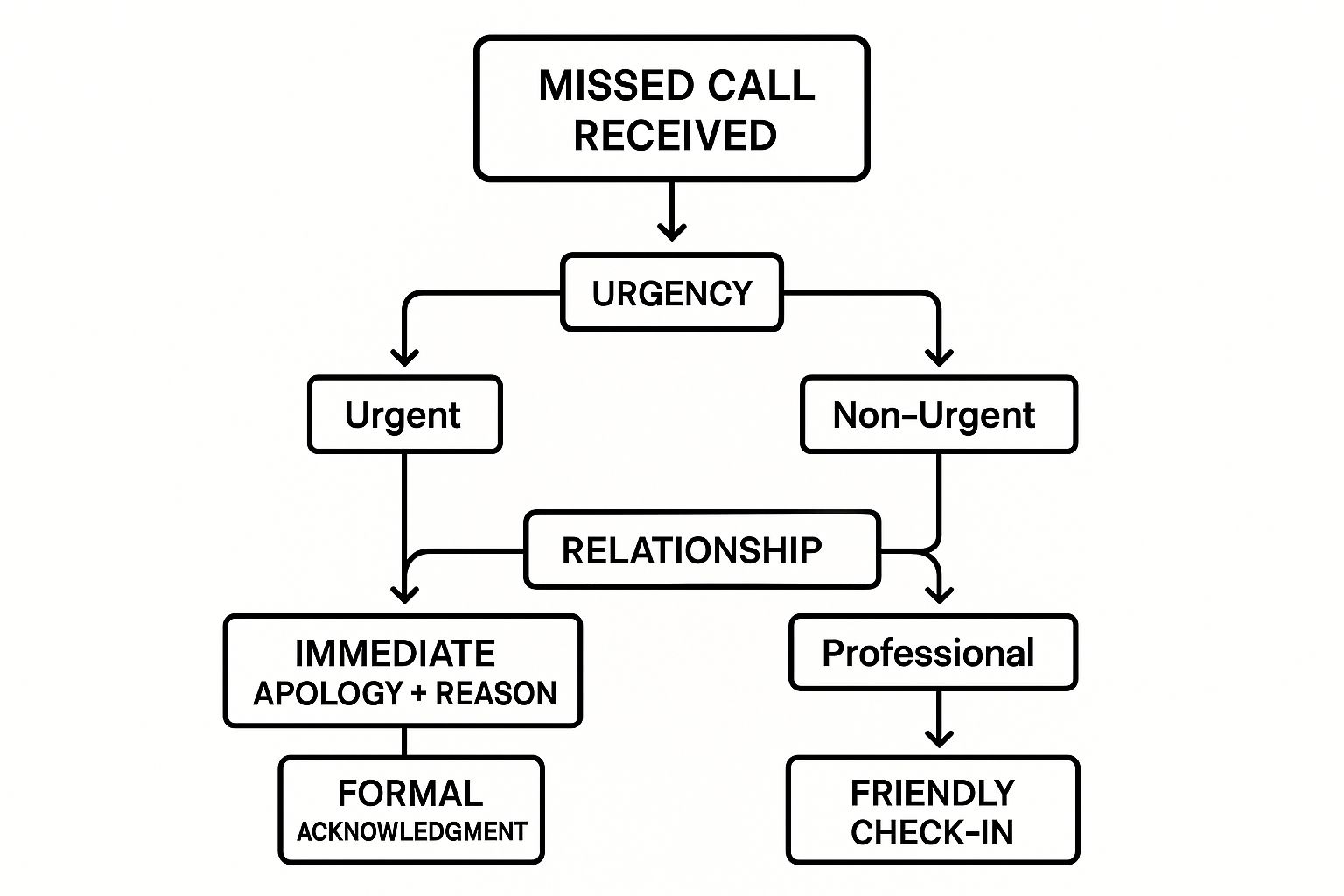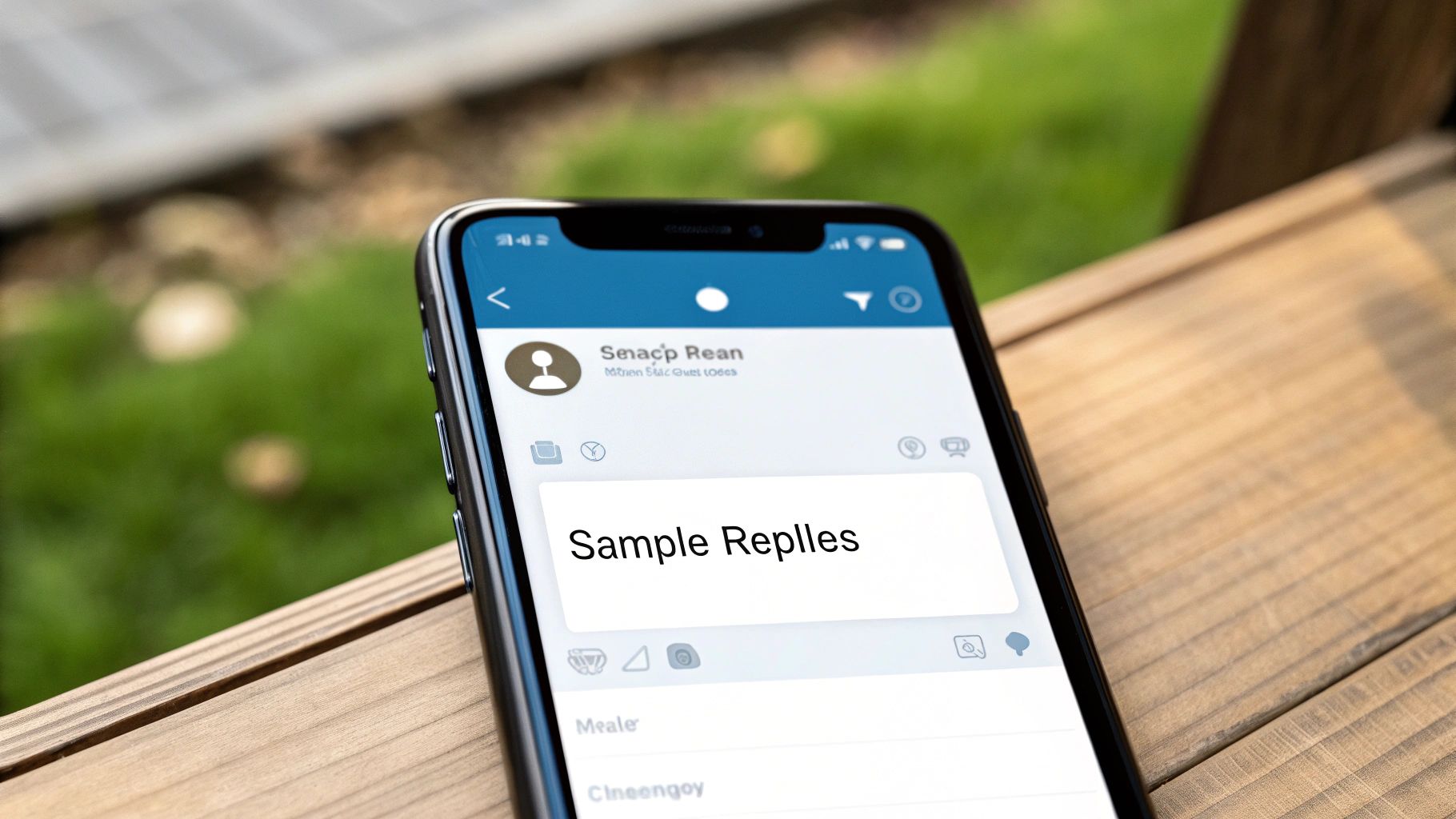A ringing phone you can’t get to isn’t just a missed call; it's a missed opportunity.
Let's be honest, we've all been there. You're on another line, helping a customer, or just can't get to the phone in time. Implementing a missed call text back system is the simplest way I've found to plug this critical revenue leak. It instantly re-engages potential customers who would otherwise hang up and call your competitor. It’s a simple, automated follow-up that turns a moment of frustration into a positive first impression.

That unanswered ring represents way more than a minor inconvenience. It's the sound of potential revenue walking right out the door. For small businesses especially, every single lead matters.
Think about the modern customer. They operate on a timeline of right now. When they need a plumber, a consultation, or an appointment, they pick up the phone expecting an immediate solution. If you don't answer, they aren’t going to wait patiently. They’ll just dial the next number on Google. That one unanswered call could be a five-figure contracting job, a new long-term client for your firm, or a new patient for your clinic.
The numbers behind this everyday scenario are pretty staggering. Research shows that, on average, businesses only manage to answer about 37.8% of their incoming calls. This means nearly two-thirds of potential customers never even speak to a person.
And it gets worse. Up to 85% of those callers won't leave a message or bother trying again. When you consider that the average value of a single missed business call is estimated at around $1,000, the financial risk becomes impossible to ignore. This highlights a massive vulnerability for any business that relies on phone calls for growth. We're not just talking about losing one customer; it's the compounding effect of lost opportunities over weeks, months, and years.
The psychology is simple: an unanswered call feels like a closed door. In contrast, an immediate, helpful text response feels like a proactive and professional acknowledgment that you value their time.
The traditional safety net for a missed call—voicemail—is quickly becoming obsolete. Let's face it, people just don't leave detailed messages anymore. Even when they do, the delay in your response can be more than enough time for them to find someone else.
To really grasp this shift, think about how modern call handling services frame the problem: a ringing phone you can't get to is the sound of money walking away.
A missed call text back system bridges this gap perfectly. It provides the instant gratification customers expect while buying your team valuable time to follow up properly. It’s more than just a tool; it's a fundamental change in how you manage your most valuable asset: your incoming leads. This proactive approach is the first, and most important, step in building a resilient lead capture process.
Let's be honest, not all automated text back systems are created equal. The "best" solution isn't about finding the one with the longest feature list. It’s about finding the one that actually fits your business—your call volume, your team's workflow, and your specific goals.
After all, the needs of a solo massage therapist are worlds away from a multi-location plumbing company fielding emergency calls. Your tool should reflect that reality.
Many businesses start with a simple SMS auto-responder, which might even be a free feature included with your VoIP phone system. That’s a perfectly fine starting point if you just need to send a single, generic message like, "Sorry we missed your call, we'll get back to you soon."
But what happens when your business grows? You'll quickly hit a wall. These basic tools just don't have the muscle to handle more complex scenarios, like integrating with your CRM, booking appointments, or understanding why someone is calling.
This is where context becomes king. You wouldn't give the same response to a new customer asking for a quote as you would to an existing client with a billing question.

The real magic happens when your system can adapt based on the caller's needs and your relationship with them. That's something only more advanced platforms can truly handle.
Once you're ready to graduate from basic auto-replies, the world of options really opens up. You’ll find everything from bare-bones texting platforms to fully conversational AI receptionists. The goal is to land in that sweet spot between powerful features and day-to-day usability.
Here’s a look at some of the common solutions you’ll come across:
Don't make the decision based on price alone. An AI receptionist might have a higher monthly cost, but if it converts an extra 25% of your missed calls into booked appointments, the return on investment blows a free, basic tool out of the water.
To help you visualize where each type of solution fits, here's a table comparing them based on common business needs.
Ultimately, the right choice will depend on your specific operational bottlenecks and growth ambitions.
To figure out what you need, start by asking yourself a few simple questions about your daily grind.
How many calls are you actually missing each day? And what's the number one reason people are calling you in the first place? The answers will point you in the right direction.
For example, if you're missing 5-10 calls a day and most are from potential new customers, an AI receptionist that can capture their info and get them on the schedule is a no-brainer. But if you only miss 1-2 calls a day, and they're usually from existing clients, a simpler auto-responder that points them to your online portal might be all you need for now.
The perfect missed call text back solution is the one that solves your biggest communication headache without overcomplicating your life.

The tech behind a missed call text back is slick, but it's the words you choose that make or break it. Let's be honest, a clunky, robotic message can feel just as frustrating as getting sent to voicemail in the first place. The real goal here is to send a text that feels helpful and human, instantly turning a missed connection into a positive interaction.
When someone calls your business, they have a problem or a question right now. Your text needs to acknowledge that urgency and immediately pivot their experience from a dead end to a solution.
A great message isn't complicated. It really just needs to do three things well. First, it has to acknowledge the missed call and apologize. Next, it needs to clearly state who you are. And finally—this is the most important part—it must give them a super simple next step.
Think of it as a quick conversation starter. You want to make it effortless for them to reply and get what they needed when they first dialed your number.
The line between a generic auto-reply and an effective text back comes down to personalization and a strong CTA. If you can, use the caller's name. Many modern AI systems can pull this information automatically, which instantly makes the message feel less like it came from a machine.
But your CTA is the real workhorse here. It guides the customer toward the action you want them to take. Vague promises like "We'll call you back soon" just leave people hanging. Instead, put them back in the driver's seat.
A strong CTA empowers the customer. Instead of making them wait for you, it gives them an immediate way to solve their problem—whether that’s booking an appointment, asking a question, or getting a quote.
This simple shift can dramatically improve your response rates and turn more of those missed calls into actual business.
The "perfect" message is going to look different depending on your business. Here are a few battle-tested examples to get your ideas flowing:
For a Law Office:
"Hi [Client Name], this is John from Apex Law Firm. So sorry we missed your call. To schedule a free consultation, you can book a time directly on my calendar here: [Booking Link]. How can I help?"
For a Home Services Business (e.g., HVAC):
"Hello! This is ACME Heating & Cooling. We're sorry we missed you. For the fastest service, just reply to this text with your address and the issue you're having. We'll get a tech dispatched right away."
For a Local Medical Clinic:
"Hi, this is the front desk at Bright Smiles Dental. We're sorry we couldn't get to the phone. Are you looking to book a new appointment or manage an existing one?"
Missed Call Text Back systems have completely changed the game, turning what used to be lost opportunities into genuine customer engagement. Think about it: most voicemails are never even listened to, but text messages boast an incredible 98% open rate. Sending an instant SMS is just a smarter way to reconnect. Psychologically, that quick acknowledgment reduces a caller's frustration, building a little bit of trust right from the start. You can learn more about how text backs build trust on callin.io.
Alright, let's move from theory to practice. This is where you actually build your missed call text back system and see the results firsthand. Setting this up isn't some complex technical nightmare; it's really just a series of smart decisions that get the technology working for your business.
First things first, you have to connect your existing business phone number. Most modern platforms give you a couple of easy options: you can either port your current number over or just forward your calls to a new number they provide. The process is usually pretty quick and means you don't lose the number your customers already have saved.
Once that's done, the system can "see" every call that comes in and, more importantly, knows the instant one goes to voicemail.
Your business isn't open 24/7, and your automated texts shouldn't pretend it is. One of the most critical first steps is to set your active business hours. This simple rule tells the AI how to handle a call that comes in during a hectic Tuesday afternoon versus one that rings at 10 PM on a Saturday.
During business hours, your message might sound something like this:
"Hi there, sorry we missed your call at [Your Business Name]. We're with another client but will get back to you shortly. How can we help?"
But after hours, it could automatically switch to:
"Hello! You've reached [Your Business Name] after hours. We'll be back at 9 AM tomorrow, but feel free to text us your question, and we'll reply first thing in the morning."
See the difference? This small tweak immediately sets the right expectations and shows the caller you're on top of things.
Now it’s time to take those message templates you worked on and plug them into the system. You’ll find that most platforms have a workflow builder where you can drop these in. The success of any great text-back system is built on solid automation principles, which is just a fancy way of saying it responds instantly and correctly every time without you lifting a finger.
Most tools let you get pretty granular with different triggers and messages. For instance:
This is all powered by backend SMS functionality from providers like Twilio, which many AI receptionist platforms use to handle the actual sending and receiving of texts.
This integration is the engine that allows your AI receptionist to reliably communicate on your business's behalf.
The last few tweaks are all about smoothing out the rough edges and preventing common mistakes. One of the most important settings to look for is a "cool-down" period.
Pro Tip: Set a rule to prevent sending more than one automated text to the same number within a 60-minute window. This stops you from accidentally spamming someone who might be having phone trouble and calling back multiple times. It’s a tiny detail that makes a huge difference in professionalism.
You also need to decide what happens after that first text goes out. A truly effective workflow doesn't just end there. Does the system wait for a reply? If they text back, does a conversational AI jump in to answer questions, or does it immediately send a notification to a team member to take over the conversation?
Thinking through these final settings is what turns your missed call text-back from a simple notification into a dynamic, automated lead-capturing machine. When you configure these rules thoughtfully, you create a system that feels personal, responsive, and genuinely helpful to every single person who calls.

Alright, so your basic missed call text-back is set up and catching those calls. That's a great start. But if you stop there, you're leaving money on the table.
Now it’s time to get strategic. Let's move beyond a simple "sorry we missed you" message and turn this tool from a simple safety net into a machine that actively grows your business. This is where you really start to see a serious return.
The magic happens when you start using conditional logic—making sure the right message finds the right person at just the right time. A smart system knows the difference between a brand-new caller and a loyal client, and that distinction changes everything. It allows for a much more personal and effective first touch.
Think about it: a first-time caller could get a friendly welcome with a link to book an introductory call. A returning client, on the other hand, might get a more familiar text, like "Hey John, good to hear from you. Need help with your recent order?" This kind of personalization makes your business feel incredibly sharp and attentive.
To really level up your workflow, you need to connect your text-back system directly to your Customer Relationship Management (CRM) platform. This is a non-negotiable step for serious businesses.
When a new lead calls and you can't pick up, the system shouldn't just fire off a text. It should simultaneously create a new lead in your CRM, tag it, and maybe even assign a follow-up task.
This seamless connection gets rid of manual data entry, which we all know is a time-sink and a recipe for errors. No more leads slipping through the cracks. Picture this: a potential customer calls, gets an instant text back, and is already logged in your system before you even realize you missed a call.
The goal is to build an automated ecosystem. Your missed call text back tool should be the gatekeeper that feeds qualified leads right into your sales and service pipeline, all without you lifting a finger.
Getting these systems to talk to each other can have a huge impact. Some businesses see as much as a 25% bump in lead conversions after automating their SMS responses. For one of our clients, this translated to an extra $15,000 in revenue each month. It just proves how critical that first, intelligent touchpoint is. You can dig into more stats on the strategic power of automated texting on GrowthHQ.io.
Ready for the next evolution? Give your system the power of conversational AI. Instead of just sending out a one-and-done message, an AI receptionist can jump in and have a natural, two-way text conversation to handle common requests.
This is where you start buying back huge chunks of your team's time.
Here are a few scenarios where AI can take over:
When you put these advanced strategies into play, your missed call text back tool becomes something much more powerful. It’s no longer just a notification system; it’s an intelligent, automated front desk that works 24/7. It captures leads, builds relationships, and streamlines your entire operation—directly boosting your bottom line.
Whenever you're rolling out something new, like a missed call text back system, it’s only natural to have a few questions pop up. Let's tackle some of the most common ones we hear from business owners just like you.
Yes, in most cases, it absolutely is. When someone dials your business number, they're initiating the conversation. This generally gives you implied consent for a direct, transactional text message in response to their call.
Think of it this way: you're not sending a random marketing promo. You're simply following up on their attempt to reach you. That said, it's always a smart move to have a quick chat with your legal counsel about TCPA compliance to make sure all your bases are covered.
It doesn't have to! In fact, a prompt, helpful automated message is almost always better than being dumped into a voicemail box or left hanging for hours. The trick is to write it with a human touch.
A great text-back message usually does three things:
Most people really appreciate the instant confirmation that their call was received and that you're on it.
The goal isn't to fool someone into thinking they're texting with a person. It's about delivering an immediate, professional, and genuinely helpful response that respects their time.
Great question, and a common worry. You don't want to spam someone who's just having trouble with their cell signal. Modern platforms are built for this exact scenario.
You can easily set a simple rule, like only sending one automated text to the same phone number within a 60-minute window. This small tweak prevents you from looking unprofessional and annoying a potential customer. It’s a simple detail that makes the whole experience feel smooth and intentional.
Ready to turn those missed opportunities into booked appointments? My AI Front Desk offers a smart AI receptionist that can manage your missed call text-backs, answer questions, and schedule clients 24/7. See how it works and get started today.
Start your free trial for My AI Front Desk today, it takes minutes to setup!








